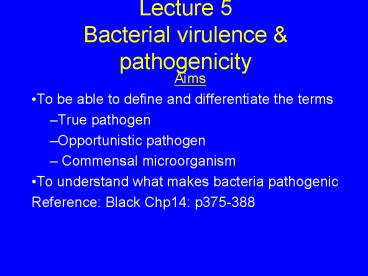Lecture 5 Bacterial virulence - PowerPoint PPT Presentation
1 / 16
Title:
Lecture 5 Bacterial virulence
Description:
Defining some important terms in microbial pathogenicty. The term pathogenic ... S.aureus. HIV. HBV ... causes a clotting of plasma (eg S.aureus) ... – PowerPoint PPT presentation
Number of Views:170
Avg rating:3.0/5.0
Title: Lecture 5 Bacterial virulence
1
Lecture 5 Bacterial virulence pathogenicity
- Aims
- To be able to define and differentiate the terms
- True pathogen
- Opportunistic pathogen
- Commensal microorganism
- To understand what makes bacteria pathogenic
- Reference Black Chp14 p375-388
2
Defining some important terms in microbial
pathogenicty
- The term pathogenic means disease causing
- A pathogen is then a disease causing microbe
- There are some further divisions of this capacity
to cause disease which are useful - True pathogen
- Opportunistic pathogen
- Commensal
3
True pathogen
- A microbe when detected is always associated is
always associated with disease - Ie. its detection is always considered
significant - eg. Salmonella typhi (typhoid)
- S.aureus
- HIV
- HBV
4
Opportunistic pathogen
- A microbe capable of causing disease when
patients are compromised in some way - eg HIV, surgery, antimicrobial treatment,
parenteral feeding, intubation, sedation - Eg Candida albicans (thrush)
- CMV
- S. epidermidis
5
Commensal microbes
- A microbe which is not under normal circumstances
pathogenic and usually forms a part of the normal
flora in/on a body site - However almost any microbe, especially bacteria,
found in the wrong site (eg by trauma is capable
of causing infection eg - E.coli (gut v UT or CSF)
- S. agalactiae (Vag. tract v Neonatal lungs,CSF
or blood - and Adult wounds)
6
Some other important definitions
- Disease an abnormal disturbance of the bodys
normal function - Contamination presence of microbes (can be the
various grade of pathogens or by commensals - Infection replication of a grade of pathogen
generally/eventually resulting in damage (insult
to the bodys normal function
7
What makes bacteria pathogenic?
- The term virulence is used in this context
- Virulence the severity of disease caused by a
pathogen - May be related to number of microbes present in a
site of infection as well as the presence of
virulence factors
8
Virulence factors
- Virulence factors are bacterial attributes which
help to overcome or avoid the hosts immune
system so that an infection can be established
9
Virulence factors contin...
- Include
- Production of enzymes
- to disrupt cell eg. haemolysin, hyaluronidase
- Clot formation eg. Coagulase
- Antibiotic inactivation eg betalacatmases
10
Virulence factors
- Production of structures
- To attach to the host eg. Pili, Flagella,
capsules - Avoid immune system eg capsules
11
Examples of virulence factors
- Hyaluronidase
- An extracellular enzyme produced by some bacteria
(eg streps) which allows the bacteria to spread
into tissue
12
Examples of virulence factors contin...
- Coagulase
- Extracellular enzyme causes a clotting of plasma
(eg S.aureus) - Does this by converting fibrinogen to fibrin in
plasma)
13
Pathogenic bacteria may contain or produce a
variety of virulence factors
- Exotoxins
- Endotoxins
- Adhesins
- Antibiotic resistance genes
- Capsules
- Immune system avoidance strategies
- eg HIV, HSV,
Capsule
Pili
Genome
Exotoxin
Endotoxin
Plasmid
Cell wall
Flagellum
14
The opportunistic pathogen
- Under normal circumstances do not cause or
associated with disease- but if provided with an
opportunity can do so-can be lethal - Compromised hosts include
- HIV (strange infections eg Crypto normal)
- Trauma (include.surgery especially prolonged)
- Invasive devices (urinary IV catheters)
- Immunosuppression (transplant)
- Cytotoxics (eg malignancy)
15
Sites where bacterial colonization occurs and
normal flora is found
- Commensal flora
- Found on most mucosal surfaces
- Some cases is transient because of antimicrobial
body products eg Skin FAs, IgA (secretory
antibody) lysozyme found in tears, saliva
mucous - Can be disrupted eg thrush
- Conjunctiva
- Nasal mucosa
- Oral mucosa
- Pharynx
- Skin
- Colon
- Rectum
- Urethra
- Vagina
16
Examples of colonization of the alimentary tract
- In general the commensal are non disease causing
in the healthy body and if they a contained in
the site - Problems occur in cases of overgrowth or invasion
into other sites eg UTI, trauma, parenteral
feeding, broad spectrum antibiotics
- Oesophagus/stomach
- Lactobacilli
- Small Intestine
- Enterococci,Lactobacilli, Enterobacteria
- Large intestine
- Enterobacteria, enterococci, bacteroides,
Bifidobacteria, Eubacteria, Peptococci,
Peptostreptococci, Clostridia, Lactobacilli































